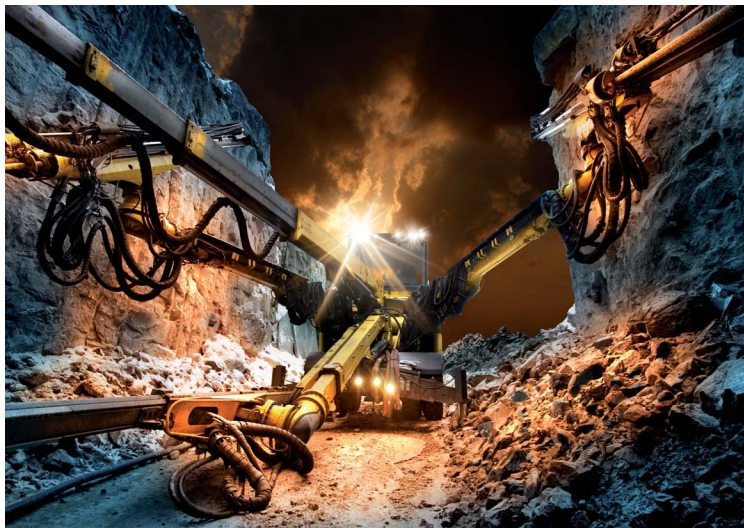Variable Frequency Drives For Mining Equipment
The mining industry is challenging, and ABB operates accordingly to the highest standard of occupational health and safety excellence and remains constantly vigilant in carrying out its duty of care. ABBs combined efforts and commitment allows it to achieve a continuing improvement in its safety record. The machines and equipment used in mining must provide reliable, safe and efficient operation in hot, humid and dusty environments. ABBs low voltage AC drives and high efficiency motors are designed to meet motor-driven application challenges found in the most hostile locations. Together with extensive mining experience and a wideportfolio of life cycle services, ABB is well positioned to tackle the industrys most demanding situations. Recent years have seen a significant increase in the level of automation and, in particular, the use of low voltage AC drives within the mining industry. Automation leads to less man power and increased safety in production, while optimizing the process and making control easier, faster and more efficient.
Replacing traditional control with variable-speed drives Low voltage AC drives are primarily used to adjust the speed and/or torque of standard AC motors. AC drives, together with induction motors, replace DC and slip-ring motors along with their control systems. AC drives also replace the need for starters, cascade drives, hydraulic speed control, mechanical gears, fan inlet vane control, fan damper control and manyother techniques of regulating the speed of electric motors used throughout the mining industry. From surface to underground mining, there are hundreds of motor-driven applications that benefit from the speed and/or torque control offered by ABB drives for mining equipment. The ever stricter targets to improve productivity and reduce energy costs are often the main reasons for selecting drives.The following benefits of ABBdrives for mining equipment can be attained using ABB low voltage AC drives. Constant changing of environmental regulations are forcing mining companies to find more energy-efficient and environmentally friendlier drilling techniques. The varying soil quality also requires a drill motor that is able to adjust its speedcontinuously. Low voltage AC drives help meet these challenges.
The drive controls the drill motor speed, ensuring the correct drilling impact is achieved for the particular soil quality. Because the motor speed is raised or lowered depending on the type of soil, the energy use is considerably reduced compared to that of hydraulic or pneumatic drilling systems. Environmental impact is lower by avoiding hydraulic liquids or compressed-air. Below are the benefits of using variable frequency drives for mining equipment:
- High uptime
- Unrivalled energy efficiency
- Extended machinery lifetime
- Lower investment, installation, operational and maintenance costs
- Improved safety and comfortable working environment Whether pumps, fans, conveyors, compressors, drills, crushers or excavators
The mining industry is a big energy user and as such is a major contributor to the emission of greenhouse gases. Replacing fixed speed motors with ABB drives for mining equipment can significantly reduce the energy consumed and the greenhouse gas emissions generated. ABB has the expertise and tools, such as its energy appraisal, to quickly identify which motor-driven applications can benefit. A replacement drive scheme is available for upgrading older, inefficient drives for new, space saving and highly efficient versions. Following an assessment of a plant, ABB helps select a replacement drive with improved efficiency and features relevant to the application.
Expertise – Variable FrequencyDrives For Mining Equipment
ABBvariable frequency drives for mining equipment are designed from a wealth of knowledge and expertise on all aspects of drive systems throughout the mining sector. ABB has dedicated experts who understand motor-drivenmining applications and can offer the quickest route to a profitable solution, without forgetting personnel safety and environmental responsibility.Leading technology in design and production For over 100 years, ABB has consistently invested a large proportion of its turnover in research and development, working closely with some of the worlds leading universities and institutions. The result is the most advanced range of low voltage AC drives in the market, designed to meet the specific needs of various mining applications. This has also led to several patents for leading edge technology within ABB drives. This cooperation contributes to the safety of ABBs products and personal safety of mining equipment users. ABB can exploit the latest component technology when designing its drive products. This results in improved quality of ABB variable frequency drives for mining equipment and in enhanced component quality. ABBs drive manufacturing facilities are equipped with the most modern assembly lines using the latest production techniques and advanced software.
Access to authoritative technical advice ABB constantly monitors all legislation, regulations, directives and standards, not only ensuring that its products comply but by offering sound advice to customers. ABBs expertise extends throughout mining operations and their entire electrical installation. ABBs engineers can advise on the correct selection, dimensioning, installation, operation and maintenance of drives, motors, transformers, relays, switches, contactors through to transducers and meters. Advice is available on long cabling, weak networks, protection functions, harmonics, EMC, power factor correction, mounting options and air flow requirements. Using harmonic filters on ABB variable frequency drives for mining equipment will eliminate the severe plant disruptions caused by harmonic disturbances in electrical equipment. ABB offers proven ways to assess your vulnerability to harmonic problems and your need for filters.Throughout mining, the consumption of inductive reactive power is significant. Reactive power compensation equipment offered by ABB helps minimize the amount of reactive power. In many applications there is a need to interface the drives with external systems. ABB has the expertise in all high performance communication protocols including PROFIBUS DP, Devicenet, CANopen and Modbus fieldbus.
To learn more about ABBvariable frequency drives for mining equipment, or for ABB drive repair and ABB drive replacement quotes, contact Precision Electric, Inc.










